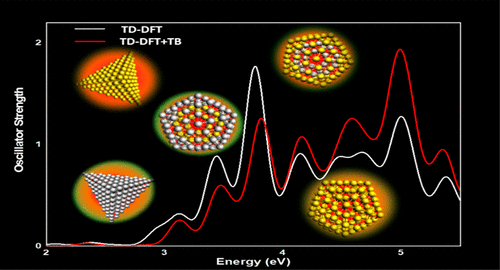当前位置:
X-MOL 学术
›
J. Phys. Chem. C
›
论文详情
Our official English website, www.x-mol.net, welcomes your
feedback! (Note: you will need to create a separate account there.)
TD-DFT+TB: An Efficient and Fast Approach for Quantum Plasmonic Excitations
The Journal of Physical Chemistry C ( IF 3.3 ) Pub Date : 2020-03-31 , DOI: 10.1021/acs.jpcc.0c00979 Narges Asadi-Aghbolaghi 1, 2 , Robert Rüger 3 , Zahra Jamshidi 4 , Lucas Visscher 2
The Journal of Physical Chemistry C ( IF 3.3 ) Pub Date : 2020-03-31 , DOI: 10.1021/acs.jpcc.0c00979 Narges Asadi-Aghbolaghi 1, 2 , Robert Rüger 3 , Zahra Jamshidi 4 , Lucas Visscher 2
Affiliation

|
We study the quantum plasmonic features of gold and silver nanoparticles using TD-DFT+TB, a new density functional theory approach to the calculation of excited states, which combines a full DFT ground state with tight-binding approximations in the linear response calculation. In this framework, the optical properties of closed-shell Ag, Au and bimetallic Ag–Au nanoparticles with tetrahedral symmetry (with 20, 56, 120, and 165 atoms) and icosahedral structure (with 13, 55, and 147 atoms) were obtained and compared to full linear response time-dependent density functional theory (TD-DFT) as a reference and also to time-dependent density functional based tight binding (TD-DFTB) as a low-cost alternative approach. We find an excellent agreement of TD-DFT+TB calculated absorption spectra with the TD-DFT reference with errors less than 0.15 eV in peak positions, while TD-DFTB shows larger errors of about 1 eV. The computational cost for the ground state calculation is identical for TD-DFT and TD-DFT+TB, but the excited state calculation becomes about a hundred times faster when applying the TB approximation and is then almost negligible for the overall timing of the calculation. In contrast to TD-DFTB, which can only be applied to element combinations for which a suitable DFTB parametrization is available, TD-DFT+TB can be applied to any combination of elements. To assess the accuracy of TD-DFT+TB for different combinations of atoms, the plasmonic properties of bimetallic clusters with different ratios of Ag and Au atoms were obtained and the trend of energy and intensity reproduced in good agreement with TD-DFT, which is not possible using TD-DFTB with standard parameter sets.
中文翻译:

TD-DFT + TB:一种高效快速的量子等离子体激元激发方法
我们使用TD-DFT + TB(一种新的密度泛函理论方法来计算激发态)研究了金和银纳米粒子的量子等离激元特征,该方法在线性响应计算中将完整的DFT基态与紧密结合的近似值结合在一起。在此框架下,获得了具有四面体对称(具有20、56、120和165个原子)和二十面体结构(具有13、55和147个原子)的闭壳Ag,Au和双金属Ag-Au纳米粒子的光学性质。并与全线性响应时变密度函数理论(TD-DFT)作参考,并与时变密度函数紧密结合(TD-DFTB)作为低成本替代方法。我们发现TD-DFT + TB计算的吸收光谱与TD-DFT参考具有极好的一致性,误差小于0。峰值位置为15 eV,而TD-DFTB则显示出约1 eV的较大误差。对于TD-DFT和TD-DFT + TB,基态计算的计算成本是相同的,但是当采用TB近似值时,激发态的计算速度大约快一百倍,因此对于整个计算时间几乎可以忽略不计。与TD-DFTB仅适用于可获得适当DFTB参数化的元素组合相反,TD-DFT + TB可以适用于任何元素组合。为了评估TD-DFT + TB对于不同原子组合的准确性,获得了具有不同Ag和Au原子比的双金属团簇的等离子体特性,并且能量和强度的趋势与TD-DFT吻合良好,这是不能将TD-DFTB与标准参数集一起使用。
更新日期:2020-03-31
中文翻译:

TD-DFT + TB:一种高效快速的量子等离子体激元激发方法
我们使用TD-DFT + TB(一种新的密度泛函理论方法来计算激发态)研究了金和银纳米粒子的量子等离激元特征,该方法在线性响应计算中将完整的DFT基态与紧密结合的近似值结合在一起。在此框架下,获得了具有四面体对称(具有20、56、120和165个原子)和二十面体结构(具有13、55和147个原子)的闭壳Ag,Au和双金属Ag-Au纳米粒子的光学性质。并与全线性响应时变密度函数理论(TD-DFT)作参考,并与时变密度函数紧密结合(TD-DFTB)作为低成本替代方法。我们发现TD-DFT + TB计算的吸收光谱与TD-DFT参考具有极好的一致性,误差小于0。峰值位置为15 eV,而TD-DFTB则显示出约1 eV的较大误差。对于TD-DFT和TD-DFT + TB,基态计算的计算成本是相同的,但是当采用TB近似值时,激发态的计算速度大约快一百倍,因此对于整个计算时间几乎可以忽略不计。与TD-DFTB仅适用于可获得适当DFTB参数化的元素组合相反,TD-DFT + TB可以适用于任何元素组合。为了评估TD-DFT + TB对于不同原子组合的准确性,获得了具有不同Ag和Au原子比的双金属团簇的等离子体特性,并且能量和强度的趋势与TD-DFT吻合良好,这是不能将TD-DFTB与标准参数集一起使用。











































 京公网安备 11010802027423号
京公网安备 11010802027423号